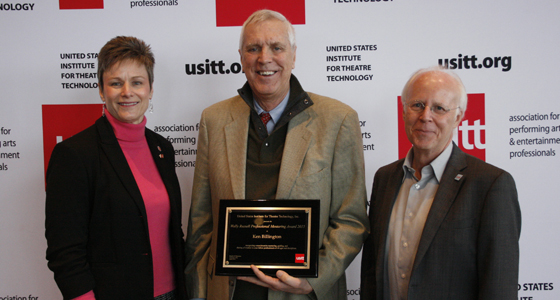We sat down at USITT 2018 with Tony Award winning lighting designer Ken Billington for a mini Q&A on his first experience with lighting, advice to aspiring designers, and those who he considers his biggest mentors.
How did you get your start in Lighting Design?
Probably the way many folks who are reading this did. I turned the lights on and off for the fourth-grade play, I thought it was terrific, everyone applauded, I wanted to do lighting. And that is the truth.
After that, I would refocus all the floodlights in the back yard so nobody could see in the back yard, but the trees looked beautiful. Then when I was in junior high school — I was in suburban New York up in Harrison, NY — I joined the stage crew, the community players, and a lot of wonderful people. They let me start lighting shows when I was in the eighth or ninth grade. I think they probably looked pretty terrible only because we had two gels, blue and amber, so everything was blue and amber. I did it, but I learned from it. And everyone was so supportive.
Then I would light anything. The community players were great to me. We did a play and a musical every year and they let me light it, and they had some money for rentals. So, that’s really how I got started. From there it was what I wanted to do as a career. I never thought twice from the fourth grade what I wanted to be when I grew up. I’m still doing it and they pay me now. So this is even better.
As a 2015 Wally Russell Professional Mentoring Award winner, who are some of your mentors?
Well I had several, but probably the biggest was Tharon Musser; lighting designer of such shows as 42nd Street, of course, Dreamgirls, many others. I was her assistant from 1967 to 1970, and that really taught me how to work in the theatre. I also worked a lot with Peggy Clark, another lighting designer. Peggy had started lighting shows in the ’40s, so I learned another perspective. When I was in high school, I worked at Rosco. They were in my home town and I made the gel books. Stan Miller and his partner Len Kraft really took me under their wing and were terrific.
But there are many people. I’ve always felt people were very kind to me, and very helpful, and taught me the right way to do things and would discipline me for doing it the wrong way, nicely of course. So I would remember not to do that again.
What role does USITT play in mentorship?
USITT brings a younger crowd, which I think is terrific. They’re interested in all sorts of theatre. You know, technical, sound, lights, and scenery. I think they’re looking for where they may want to end up. USITT is a good platform for them because there’s so much geared to somebody who’s just starting out. I think USITT helps them focus where they would want to go in the world of theatre, television, concerts, and entertainment in general. It’s a good event, and boy have I watched it grow over the years.
any advice for aspiring lighting designers?
With aspiring lighting designers, I think the best thing you can do, is to light shows. Now that sounds really silly because nobody will hire me to light a show. But I think lighting anything, whether it’s a dance in the gym, somebody’s backyard, or a concert with four lights, 10 lights, or 400 lights; whatever it is, the more you do it the better you are at it. If you’re smart enough to learn from your mistakes and learn what was good and what was bad, look at it all, and just store it and say the next time you get this piece of equipment, or this temperamental person, or this limited time frame, you can go back and look at what you had done previously and say, “Ah, I went through that once.”
So my biggest thing is light, and I mean light anything. The biggest thing is if you take the “anything” job and you know the job is 12 lights and six dimmers, whatever it is, you can’t complain about that. You do the job and you make it as good as you can make it. You take those 12 lights and those six dimmers, and you do this big musical, and you do it with a smile on your face and you make it as good as you can make it. But you don’t sit and complain the whole time that you really need 14 lights and seven dimmers.
